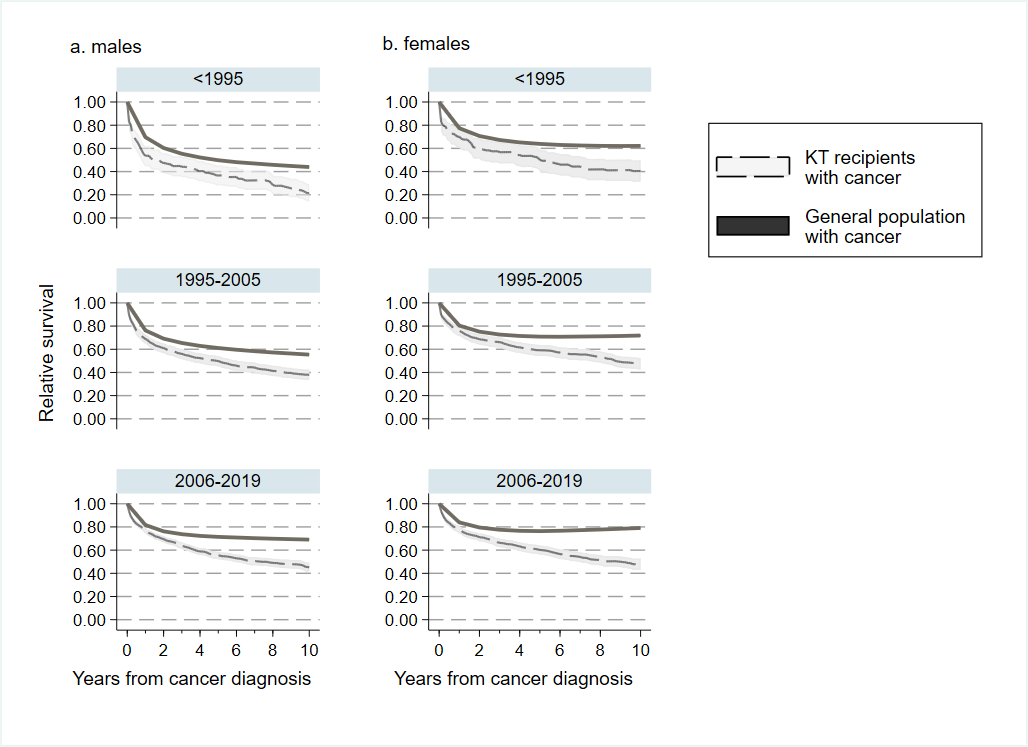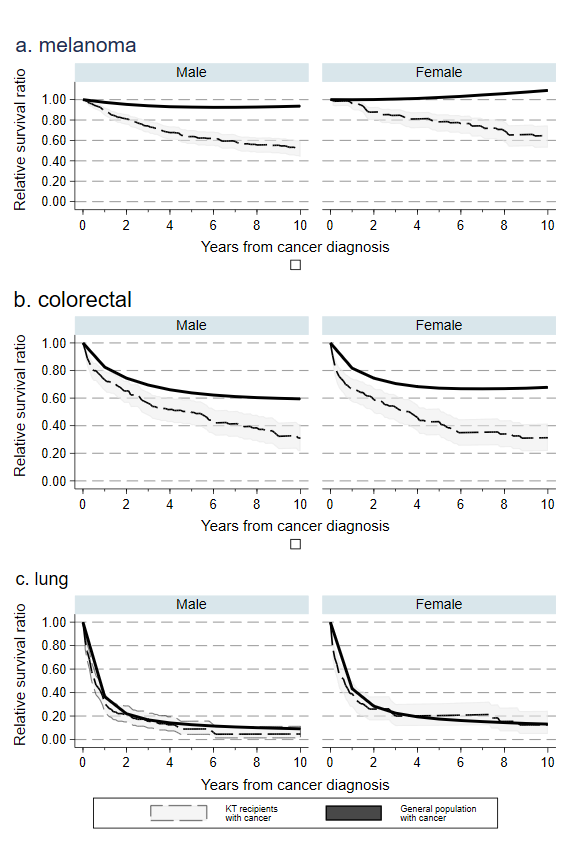
Understanding sex differences in relative cancer survival in kidney transplant recipients: A bi-national study, 1980-2019
Brenda Maria Rosales1, Laia Oliveras-Pages2, Nicole De La Mata1, Melanie Wyld1, Patrick Mark3, Michael Sullivan3, Jennifer Lees3, Angela C Webster1,4.
1Sydney School of Public Health, The University of Sydney, Sydney, Australia; 2Nephrology Department, Hospital Universitari de Bellvitge, L’Hospitalet de Llobregat, Barcelona, Spain; 3Cardiovascular & Metabolic Health, University of Glasgow, Glasgow, United Kingdom; 4NHMRC Clinical Trials Centre, The University of Sydney, Sydney, Australia
SHE-ROCKS.
Introduction: Differences in cancer mortality compared to the general population have been described in kidney transplant recipients. We sought to estimate the relative survival for site-specific cancers developed after kidney transplantation and describe differences in trends between males and females.
Method: Survival of all kidney transplant recipients with de novo cancer in Australia and New Zealand from 1980 to 2019, compared with the general population with cancer. Relative survival ratios (RSR) post-cancer diagnosis were estimated by cancer site using the general population as the reference group, matched for sex, age, calendar year, and country. Excess mortality ratios (EMR), the difference in excess mortality between kidney transplant recipients with cancer and the general population with cancer, were estimated using Poisson regression adjusted for sex, year-period of cancer diagnosis, age, country and type of kidney replacement therapy.
Results: There were 1,899 deaths in 3,253 kidney transplant recipients with de novo cancer in the cohort, 1,947 (60%) males and 1,306 (40%) females. Median follow-up was 14 years from transplantation and 3.3 years from the first cancer diagnosis.
Considering any cancer overall, in both the general population and the transplant population, females had better relative survival than males (general population females Five-year RSR 0.71 [95%CI:0.71-0.72] vs males 0.63 [95%CI:0.63-0.63], and transplant population females five-year RSR 0.59 [95%CI:0.56-0.62] vs transplant males 0.53 [95%CI:0.50-0.55]). However, comparing transplanted and general populations with cancer showed transplanted females with cancer experienced 41% higher excess mortality than females in the general population with cancer (adjusted EMR 1.41 [95%CI:1.30-1.54]), where transplanted males had 26% excess mortality (adjusted EMR 1.26 [95%CI:1.18-1.36]). Excess mortality for cancer (all sites) has increased at a steeper rate in female recipients compared to male recipients in the past 30 years (Figure 1, p<0.001).

Considering specific common cancers, comparing the transplanted with the general population showed relative survival was highest for melanoma (female five-year RSR 0.78 [95%CI:0.67-0.85; male five-year RSR 0.64 [95%CI:0.57-0.70]). Relative survival was less for colorectal; females' five-year RSR was 0.43 [95%CI:0.33-0.54], and males 0.50 [95%CI:0.40-0.58], and for lung cancer, females five-year RSR 0.20 [95%CI:0.12-0.31], and males 0.09 [95%CI:0.04-0.16]. Female kidney transplant recipients experienced greater excess mortality compared to male recipients for melanoma and colorectal cancer (p<0.001) but not lung cancer (Figure 2).

Conclusion: Female kidney transplant recipients with cancer had better relative survival than males but experienced higher survival deficits (excess mortality ratio) when compared with the general population with cancer. Relative survival and excess mortality differed by cancer site for each sex. Understanding any systematic differences in health service use and treatment interventions by sex may help explain these findings.
Women in Transplantation, The Transplantation Society. University of Glasgow & University of Sydney Collaboration Seed Funding. Australian and New Zealand Dialysis and Transplant Registry (ANZDATA). Australian Institute of Health and Welfare (AIHW). New Zealand Ministry of Health.
[1] cancer
[2] survival
[3] transplant registry
[4] sex and gender
[5] population study
[6] mortality
